Common menu bar links
Fifteenth Annual Report to the Prime Minister on the Public Service of Canada
Annex 1: A Demographic Picture of the Federal Public Service
Table of Contents
Part I – Demographic Profile of the Public Service
1. Context
2. Population Size of the Public Service
3. Public Service Diversity
4. Shift to more “knowledge-intensive” work
5. Regional Distribution
6. Employment Status
7. Shift in Age Profile
8. Retirements
Part II – Demographic Profile of Executives
1. Population Size of the Executive Group
2. Executive Diversity
3. Regional Distribution
4. Age of Executives
5. Retirements
Introduction
This Annex summarizes extensive recent work to establish a comprehensive demographic picture of the federal public service1. This profile not only depicts the current public service workforce as of March 2007, but also provides consistent historical comparisons back to 1983. Part I of this Annex focuses on the public service as a whole; Part II deals with executives.
- 255,000 employees (251,000 in 1983)
- 54.5% women (42% in 1983)
- 40% of executives are women (less than 5% in 1983)
- 60.6% of employees in the regions and 39.4% in the National Capital Region
- 85.3% indeterminate employees; 10.2% term employees; 5% casuals and students
- 70.5% declare English their first official language; 29.5% declare French
- Average age 44 years (39 in 1983)
- Average age of executives 50.6 years (48.7 in 1983)
- Public service 0.8% of the Canadian population (1% in 1983)
- Size of the public service almost unchanged compared with 1983; government program spending (constant dollars) up 30%
Part I – Demographic Profile of the Public Service
1. Context
- There were nearly the same number of public servants in 2007 (254,600) as there were in 1983 (250,800). For comparison, the Canadian population increased from 25.6 million to 33.0 million in this period. Thus, as a proportion of the Canadian population, the public service decreased from 1.0% in 1983 to 0.8% in 2007. Looked at from another perspective, between 1983 and 2007 real GDP doubled and total federal program spending in constant dollars increased by 30%, while the public service was essentially the same size at the beginning and the end of this period.
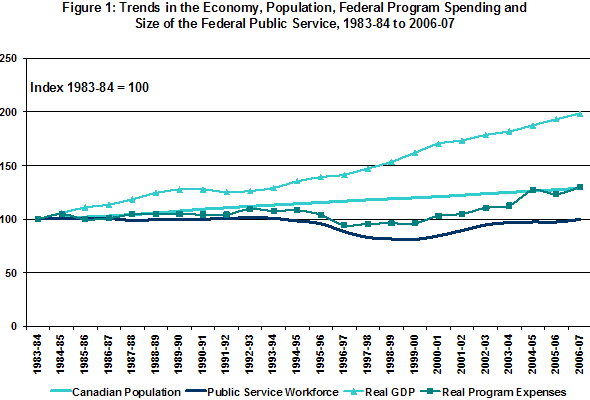
2. Population Size of the Public Service
- The size of the public service has varied considerably over the 1983-2007 period. After remaining fairly steady in the 1980s, it declined by 19% as a result of Program Review budget reductions in the mid 1990s. Between 1999 and 2007, reflecting a total program spending growth of 35%, public service employment increased by 25%. Much of this growth (19%) occurred from 1999 to 2003, as a result of investments in areas such as security.
- During the past 25 years, there have also been many changes in the structure of the public service. For example, in the late 1990s the Canada Customs and Revenue Agency, Parks Canada and the Canadian Food Inspection Agency became separate employers. Other activities such as air navigation, airport management and labour market programs were devolved outside the federal public service.
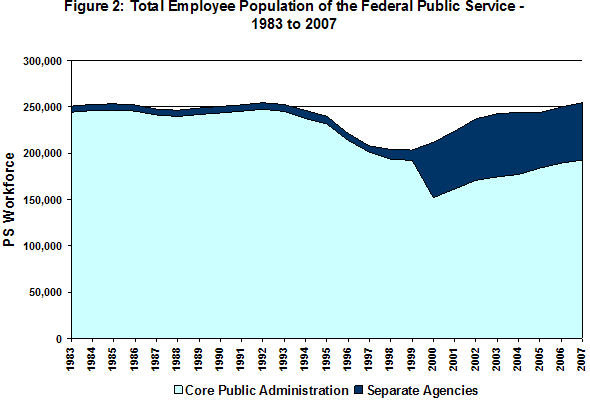
3. Public Service Diversity
a) Gender

- One of the most striking changes in the public service over the last 25 years has been the reversal in gender representation. Women are now the majority of public servants (54.5%), versus 42% of the public service in 1983.
b) Employment Equity Groups
- The representation of all designated employment equity groups has been steadily increasing. All groups except visible minorities now exceed their labour market availability based on the 2001 Census.
- As noted above, women were at 54% in 2006 (workforce availability 52.9%); Aboriginal peoples at 3.8% (availability 2.5%); persons with disabilities at 5.5% (availability 3.7%); and visible minority employees at 9.6% (availability 10.7%).
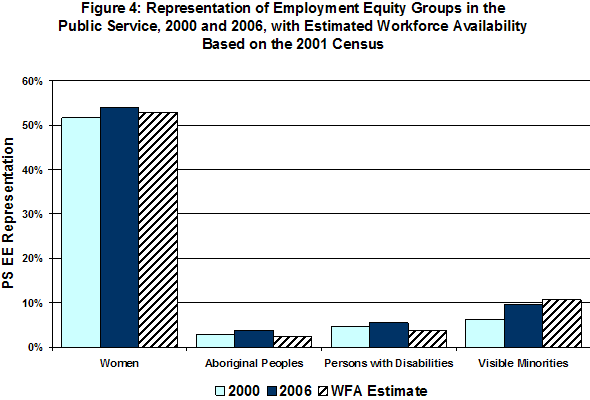
c) Language
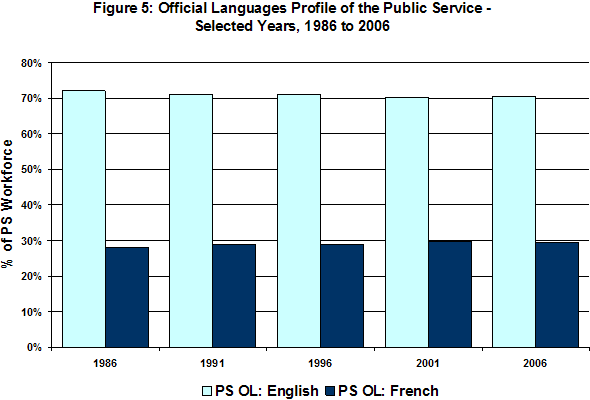
- The proportions of those whose first official language is French and English have been fairly steady over the last 25 years, albeit with a slight increase in the share of francophones. Between 1986 and 2006, those identifying French as their first official language grew from 28% of the public service to 29.5%.
4. Shift to more "knowledge-intensive" work
- Since the early 1980s, there has been a clear trend toward more knowledge-intensive work in the public service. Comparing today’s workforce with 1983, there are five times as many computer and systems specialists; four times as many lawyers; and three times as many economists and physical scientists.
- The five largest knowledge-intensive occupations have all increased in size proportionately since 1983. In 2007, they represented 40% of the public service workforce, more than double their share of about 18% in 1983.

5. Regional Distribution
- Approximately 61% of the public service workforce today is located in the regions, somewhat lower than the 67% in 1983. An important factor in this decrease has been the devolution of air navigation, airport management and labour market programs, whose employees were largely concentrated in the regions.

6. Employment Status
- Over the past 25 years, the percentage of indeterminate staff has remained relatively constant, fluctuating between 86.2% in 1983 and 81.6 % in 1998. In 2007, the proportion was 85.3%.
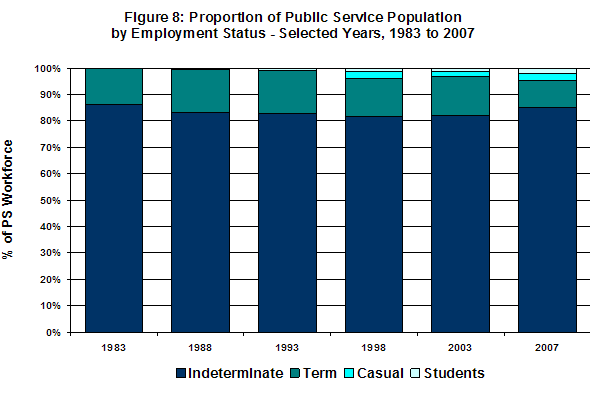
7. Shift in Age Profile
- The distribution of employees by age over the last 25 years is illustrated in Figure 9. The average age of public servants in 1983 was 39.2, compared with 44.3 in 2007. The median age increased even more from 36 in 1983 to 45.4 in 2007.

- In Figure 9, each vertical bar represents two years of age. Age bands are distinguished by different colours. The areas identified with “forward slashes” highlight the “baby boom” generation.
- This figure shows the demographic dominance of the “baby boom” cohort. This cohort has been driving public service demographics for the past 25 years, and its aging signals the urgency of renewal.
8. Retirements
- Figure 10 shows annual departure rates from the public service2 for retirement and other reasons over the period from1990-91 to 2006-07.
- As the Figure indicates, retirements were just over 2% per year in the early 1990s, fell during Program Review to just over 1%, and since that time have risen steadily to more than 3% per year. Other separations, voluntary or involuntary, have been around 2% per year since Program Review. The large bulge in the middle of Figure 10 resulted from “Program Review” staff reductions.
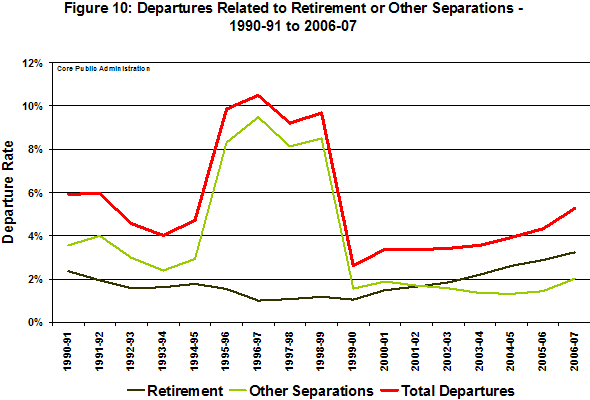
- Projecting these trends forward conveys a clear demographic message. The percentage of public servants who were eligible to retire without a penalty has significantly increased since the late 1990s, rising from 3.5% in 1998 to 8% in 2007. Over 25% of the March 2007 population will be eligible to retire by 2012. Approximately one third of those who are eligible to retire typically retire in the first year of eligibility.
Part II – Demographic Profile of Executives
1. Population Size of the Executive Group
- As of March 31, 2007, there were 5,600 executives in the federal public service.
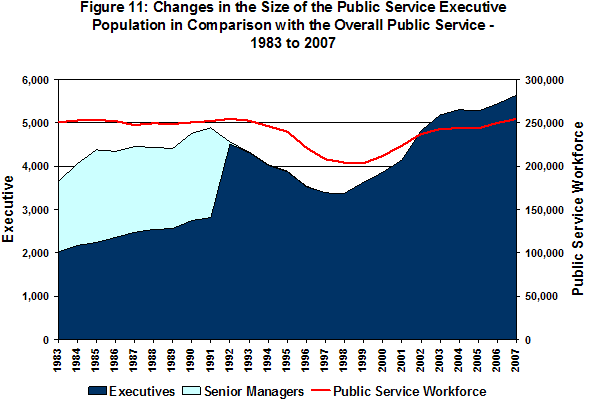
- The number of executives grew through the 1980s, and then declined during Program Review, along with overall reductions in the public service. Since the late 1990s, the executive workforce has grown faster than the public service as a whole. (The large increase in executives in 1991-92 resulted from combining the former senior manager group with the executive group.)
2. Executive Diversity
a) Gender
- Shifts in gender representation in the public service have been very significant over the last 25 years, and even more so at the executive level.
- Overall, the proportion of women among executives has increased from less than 5% in 1983 to about 40% in 2007. This pattern applies fairly consistently across all executive levels.
- Women held 38% of Deputy Minister and Associate Deputy Minister level positions in 2007, compared to less than 2% in 1983.

b) Employment Equity Groups
- Representation of designated equity groups among executives has increased since 2000. As of March 31, 2007, it was above Workforce Availability (WFA) estimates for persons with disabilities, but below for women, Aboriginal people and visible minorities.
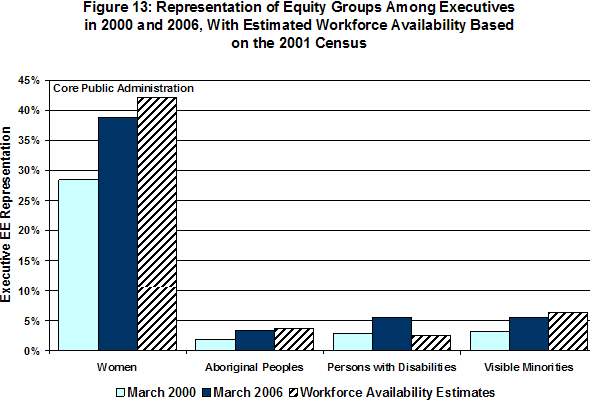
c) Language
- The proportion of executives declaring French as their first official language has increased from 21% in 1983 to 29% in 2007.

3. Regional Distribution
- While executives are predominately located in the National Capital Region (about 71% in 2007), this proportion is somewhat lower today than in 1983 (76%).
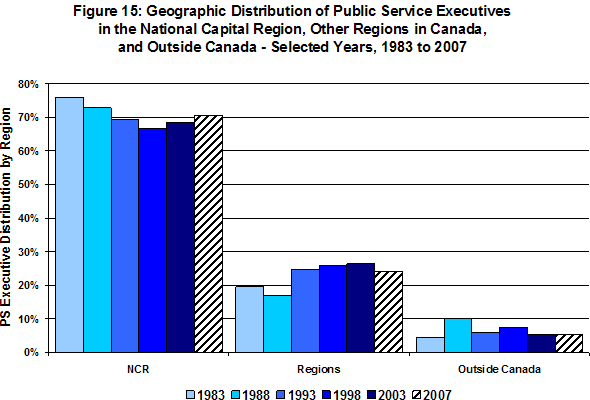
4. Age of Executives
- The average age of executives in 1987 was 48.7 years. By 2007, this had risen to 50.6 years.
- The average age of level 1 to 3 executives had increased to 50.4 years in 2007, while the average age of Assistant Deputy Ministers (levels 4 and 5) had increased to 54 years.
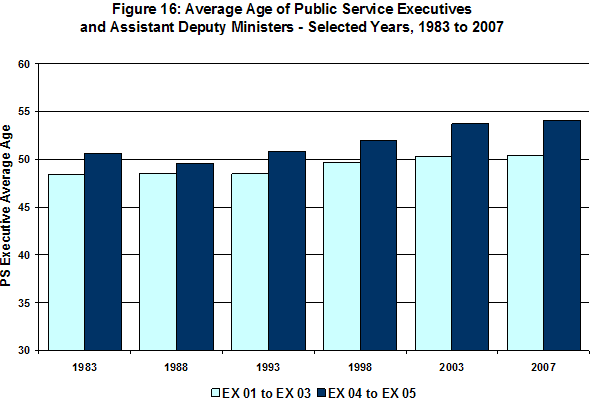
- In 1987, the majority of executives (59%) were under 50; today the majority (57%) are over 50. The largest proportion of executives in 1987 were between 40 and 44 (25.3%); now the greatest number are those 50 to 54 (29.4%).
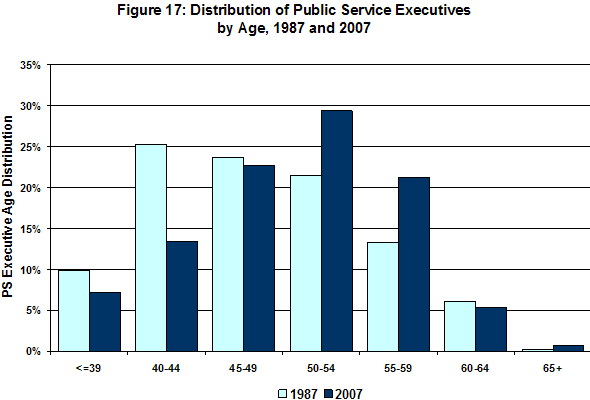
5. Retirements
- In March 2006, approximately 17% of the executive population was eligible to retire. The actual retirements in 2006-07 were approximately 7.5%.
- By 2012, almost half of those in executive positions in March 2007 will be eligible to retire.
- Figure 18 illustrates the fact that executives have significantly more pensionable years of service now than they did in 1987. In that year, 44% of executives had more than 20 years of pensionable service; by 2007 this figure had risen to 65%.
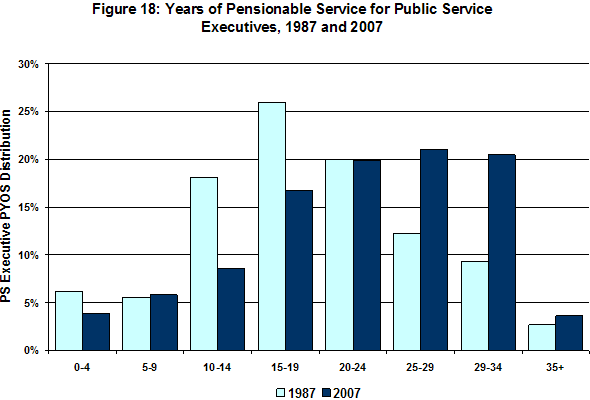
1. By “public service” we mean the core public administration (those departments and agencies for which the Treasury Board is the employer) and the separate employers (principally the Canada Revenue Agency, Parks Canada, the Canadian Food Inspection Agency, and the National Research Council).
2. Data covers only the “core public administration,” that is, the departments and agencies for which the Treasury Board is the employer.
[Previous] [Table of Contents] [Next]


